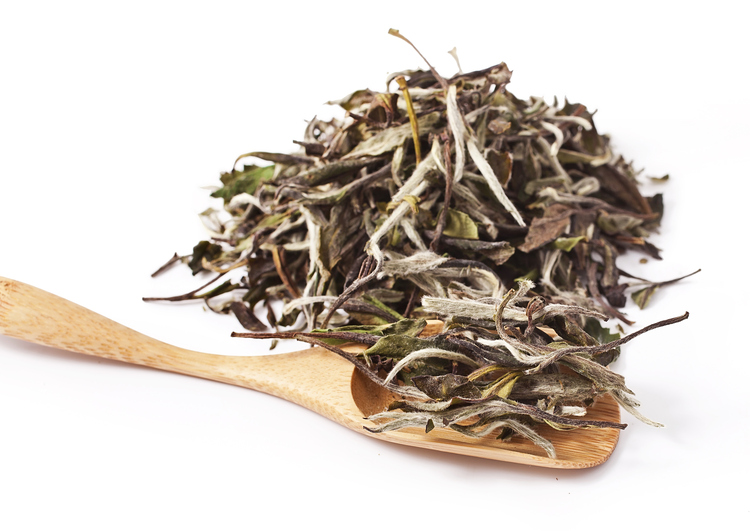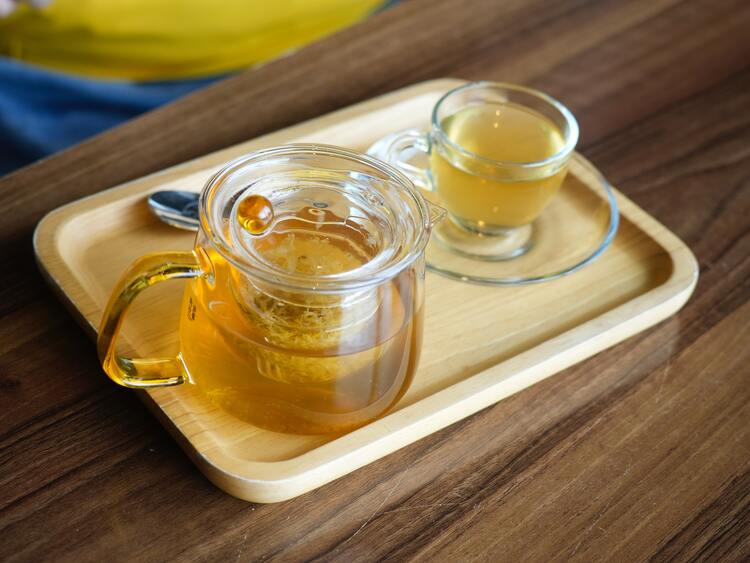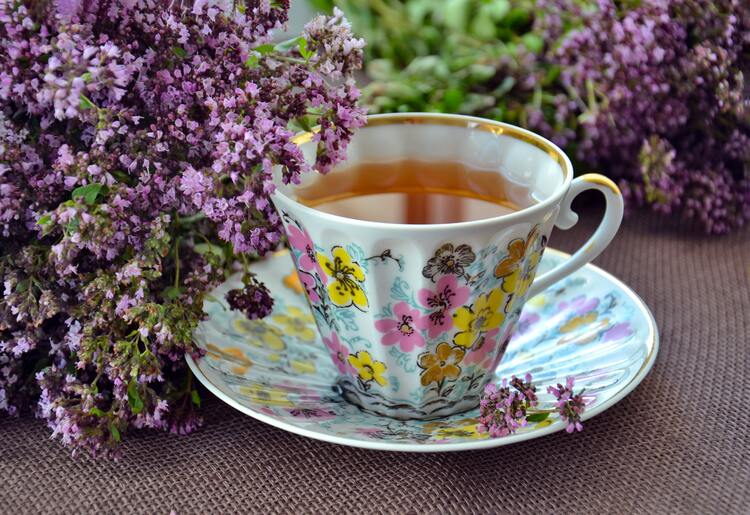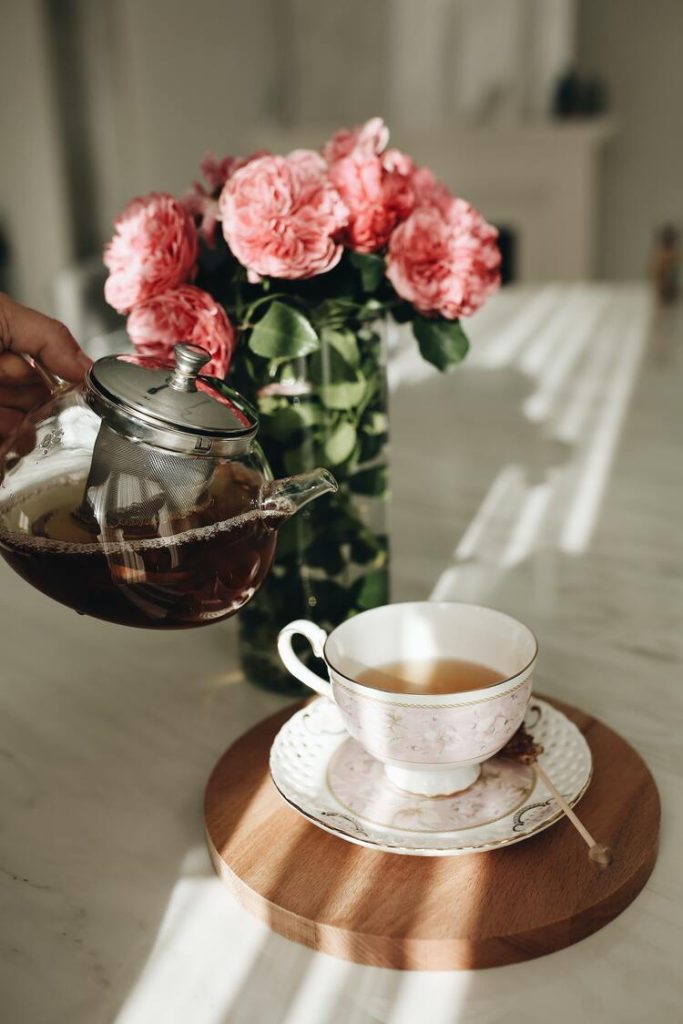As you sip on a warm cup of White Peony Tea, you’re indulging in a delightful beverage, with a rich history, and tradition. Known for its delicate flavor and numerous health benefits, this tea is cherished by tea connoisseurs worldwide.
This article will discuss its origins, processing methods, and interesting characteristics. Furthermore, we will provide brewing instructions and ideas on how to use the tea in several delectable beverages.
Please note: This article contains affiliate links, meaning I may earn a commission if you make a purchase by clicking a link. Of course, this comes at no extra cost to you and helps me keep offering readers solid information.

White Peony Tea Overview
Origins and History
White Peony, known as Bai Mudan or Pai Mu Tan in Chinese, is a delicate and flavorful white tea you’ll love exploring. It originates from the Fujian province of China, and its production dates back to the early 20th century. This well-known tea comes from the same plant, Camellia sinensis, as other famous teas, but its minimal processing sets it apart.
Fuding and Zhenghe Counties
The two primary regions where the tea is produced are the Fuding and Zhenghe counties. Each location has its unique characteristics, which affect the taste of the tea:
- Fuding: The teas from Fuding are generally lighter and more delicate, offering a sweet and floral taste. The leaves in this region gain a more jade-green color during the processing.
- Zhenghe: Zhenghe’s tea has a stronger, more robust flavor with a slight astringency. The leaves from this area tend to be darker in color, exhibiting shades of brown and green.
Cultivars
White peony tea is typically made from a specific cultivar of the Camellia sinensis plant known as “Da Bai,” which translates to “Big White” in Chinese. This cultivar is characterized by its large, downy white buds and leaves, prized for their delicate flavor and appearance.
In addition to the Da Bai cultivar, some white peony teas might include a blend of other cultivars, but the primary component is usually the Da Bai variety. This cultivar’s buds and young leaves are selected for their freshness and tenderness, which contribute to the high-quality and mellow character of white peony tea.
Note: A cultivar is a plant cultivated to yield certain characteristics. Cultivars are not true to seed, meaning they propagate through cuttings, grafting, and other methods.
Production Process
White Peony Tea is produced using a carefully crafted process. The production process involves using high-quality raw materials and following a specific set of steps to create a tea that is both delicate and flavorful.
Raw Materials
The raw materials used are the young leaves and unopened buds of the Camellia sinensis plant. The leaves and buds are picked during the early spring when they are still covered in fine white hairs, which gives the tea its distinctive appearance and delicate flavor.
The leaves and buds are carefully selected, with only the highest quality making the final cut.
Process
The freshly plucked tea leaves are spread out in a thin layer and left to wither. This step reduces the moisture content in the leaves, making them softer and more pliable. Traditionally, withering was done outdoors under natural sunlight. However, controlled indoor withering is also common, especially for higher-quality white teas.
After withering, the tea leaves are dried to halt further enzymatic activity and preserve their flavor and color. The drying process is typically done at a low temperature to prevent the tea from becoming too roasted or altering its delicate characteristics. This step is crucial for maintaining white tea’s fresh and light qualities.
Noticed this tea’s leaves are not rolled or shaped. The tea leaves have diverse shapes and sizes.
Once dried, the tea leaves are carefully sorted and graded based on their size, appearance, and quality. The tea is packaged and sealed to maintain its freshness. High-quality white teas are often vacuum-sealed or stored in airtight containers to prevent moisture and odors from affecting the tea’s flavor.

Preparation and Brewing
Brewing White Peony Tea involves a gentle approach to bring out its delicate flavors while avoiding bitterness or astringency. Here’s a step-by-step guide on how to brew white peony tea:
Ingredients and Tools
- White peony tea leaves
- Fresh, filtered water
- Teapot or gaiwan
- Teacup or tasting cup
- Tea strainer (if needed)
- Timer
Brewing Steps
- Preheat Equipment: Warm up your teapot, gaiwan, and teacup by rinsing them with hot water. This helps maintain the optimal brewing temperature.
- Measure Tea: Measure out the appropriate amount of white peony tea leaves. A general guideline is 1 to 1.5 teaspoons of tea leaves per 8 ounces (240 ml) of water. Adjust the amount based on your taste preferences and the size of your teapot or brewing vessel.
- Water Temperature: Heat fresh, filtered water to around 175°F (80°C). White peony tea is delicate, so using too hot water can result in over-extraction and bitterness.
- Rinse the Leaves (Optional): This step is not always necessary, but you can quickly rinse the tea leaves with hot water and immediately discard the water. This helps to awaken the leaves and remove any initial dust or impurities.
- First Infusion:
- Place the rinsed or dry tea leaves into the teapot or gaiwan.
- Pour the heated water over the tea leaves, covering them completely.
- Allow the tea to steep for about 1-2 minutes. Since white peony tea is delicate, a short steeping time for the first infusion is recommended to avoid over-brewing.
- Pour and Enjoy: After the steeping time, gently pour the brewed tea into your teacup or tasting cup. White peony tea has a mild and subtle flavor profile, so take your time to appreciate its nuances.
- Subsequent Infusions: White peony tea leaves can be steeped multiple times. For each subsequent infusion, increase the steeping time by a little (for example, 15-30 seconds longer than the previous infusion). You can generally enjoy 2-3 infusions or more, each revealing slightly different flavors and aromas.
- Experiment: Feel free to adjust the tea leaf amount, water temperature, and steeping time to suit your taste preferences. Some people prefer a slightly longer steeping time for a bolder flavor, while others stick to shorter times to maintain the tea’s delicate nature.
Loose Leaf vs. Tea Bags
Now, let’s talk about loose-leaf vs. tea bags. While both options offer the enchanting taste of White Peony Tea, using loose leaves typically results in better flavor and aroma. Here are some advantages and disadvantages of each option:
Loose Leaf
Pros
- Better flavor and aroma due to less processing
- Allows leaves to expand in the water, releasing all their flavors fully
- It is more environmentally friendly, as there’s no need for packaging
Cons
- May require more preparation & equipment
Tea Bags
Pros
- Convenient and easy to use, especially on-the-go
- Allows for precise portion control, as each bag contains a pre-measured amount
Cons
- Slightly lower quality compared to loose-leaf
White Peony Tea Flavor Profile
White peony tea is known for its delicate and nuanced flavor profile. The taste of the tea is often influenced by factors such as the specific cultivar used, the region of origin, and the processing methods. However, some common flavor characteristics of white peony tea include:
- Subtle Sweetness: This tea often has a natural, gentle, and not overpowering sweetness. This sweetness is reminiscent of honey or nectar, giving the tea a pleasant and inviting quality.
- Floral Notes: Floral undertones are familiar in this tea. You might detect floral aromas that range from light and fresh to slightly more pronounced. These floral notes can contribute to the tea’s aromatic complexity.
- Fruity Aromas: Some White Peony Teas exhibit fruity aromas and flavors. These can include melon, peach, apricot notes, or even a hint of citrus. These fruity undertones add a refreshing quality to the tea.
- Mild Nuttiness: The tea may have a subtle nutty undertone, similar to almond or chestnut.
- Creamy and Silky Texture: The tea is often described as having a smooth and silky texture on the palate.
- Clean and Refreshing Finish: The lightness of White Peony Tea is often accompanied by a clean and refreshing finish. This makes it an enjoyable choice for those who prefer teas with a more delicate and mild aftertaste.
- Low Astringency: White peony tea is typically low in astringency and bitterness, especially when brewed correctly with water at the appropriate temperature and for a reasonable duration.
- Lingering Notes: Despite its delicate nature, white peony tea can leave a pleasant and lingering aftertaste that invites you to savor the experience.

White Peony Tea Health Benefits
One of the prominent components in White Peony Tea is its high level of antioxidants. These compounds are vital in combating free radicals that can damage your cells and contribute to aging and diseases like heart disease. Drinking White Peony Tea can provide:
- Reduced inflammation: This tea can help alleviate chronic inflammation thanks to its anti-inflammatory properties.
- Enhanced immune system: The antioxidants in the tea can strengthen your immune system, making it easier to fend off bacteria and illnesses.
This tea, as other white teas, contains less caffeine compared to other teas. This makes it a perfect choice if you’re looking to reduce your caffeine intake without sacrificing flavor or health benefits. Some of the advantages of lower caffeine content include:
- Better sleep: With less caffeine, you can enjoy White Peony Tea in the evening without disturbing your sleep patterns.
- Reduced jitters: For those sensitive to caffeine, this tea offers a more gentle alternative that won’t leave you feeling anxious or jittery.
These health benefits can make this delightful tea a valuable addition to your daily routine.
Beverages Using White Peony Tea
White Peony Tea can be enjoyed on its own or used as a base for a variety of drinks. Here are a few ideas for drinks that can be prepared using the tea:
- Iced Tea: Brew a batch of this white tea and let it cool to room temperature. Pour the tea over ice and squeeze lemon or lime for a refreshing and hydrating drink.
- Tea Latte: Brew a cup of tea and add steamed milk and a touch of honey for a creamy and comforting drink.
- Smoothie: Blend brewed White Peony Tea with frozen fruit, such as berries or mango, and a splash of coconut milk for a delicious and nutritious smoothie.
- Tea Cocktail: Mix the tea with your favorite spirit, such as vodka or gin, and add a splash of fruit juice for a sophisticated and refreshing cocktail.
- Tea Mocktail: Mix brewed tea with sparkling water and a splash of fruit juice for a non-alcoholic and flavorful drink.
- Tea Spritzer: Mix brewed White Peony Tea with sparkling water, a lime squeeze, and a mint sprig for a bubbly and refreshing spritzer.

Culinary Uses
Since I like this tea so much, I want to provide you with some ideas regarding culinary uses.
- Infusing in Milk or Cream: The tea can be infused in milk or cream to add a delicate and floral flavor to baked goods such as cakes, cupcakes, and cookies. Heat the milk or cream and steep a tea bag or loose-leaf tea for a few minutes before using it in your recipe.
- Poaching Liquid: It can also be used as a poaching liquid for pears, peaches, or apples. The tea will infuse the fruit with a delicate floral flavor and create a beautiful presentation.
- Marinade for Meat or Fish: White Peony Tea can be used as a marinade for meat or fish to add a unique flavor to your dish. Steep the tea in hot water and mix it with your favorite herbs, spices, and oil. Let the meat or fish marinate for a few hours before cooking.
- Salad Dressing: This is one of my favorite ways to use the tea. Mix the brewed tea with olive oil, vinegar, honey, and your favorite herbs and spices for a healthy and flavorful dressing. This works well with a mix of greens and even coleslaw mix.
Purchasing White Peony Tea
When it comes to purchasing White Peony Tea, you have several options to choose from. If you prefer to buy tea online, you can check out Amazon, which offers a variety of white peony tea options, including loose-leaf and tea bags. Many local tea shops and health stores also carry white peony tea.
When selecting your tea, you may come across the following:
- Loose leaf tea
- Tea bags
- Tea powder
While loose-leaf and tea bags are more common, white peony tea powder is a flexible option that allows you to experience the benefits of this delicate beverage in smoothies, baked goods, and other recipes.
Here are some options:
Organic Positively Tea Company, White Peony Tea

Tian Hu Shan Original Mai Bu Dan

Davidson’s Tea Bulk, White Peony


Storage Tips
Once you have purchased your tea, it’s essential to store it correctly to maintain its freshness and delicate flavor. Here are some storage tips for your white peony tea:
- Please keep it in a cool, dry place. The tea should be stored away from direct sunlight, heat, and moisture. A pantry or cupboard works well.
- Use airtight containers: Store your tea’s flavor and freshness in an airtight container. Glass, ceramic, or stainless steel containers are ideal choices.
- Avoid storing near strong smells: Tea can absorb odors from its surroundings, so keep your white peony tea away from strong-smelling foods or household items.
- Please keep it away from oxygen: Minimizing exposure to oxygen can help maintain the tea’s freshness. If you purchase loose-leaf tea, seal the container tightly after each use.
By following these purchasing and storage tips, you can enjoy the delightful taste and health benefits of white peony tea for an extended period. Cheers to a delightful tea experience!

Hope you have enjoyed the article and learned something new! See you next time!
Have you tried this white tea?
More About Tea
What Does White Tea Taste Like?
What Does Black Tea Taste Like?
What Does Green Tea Taste Like?